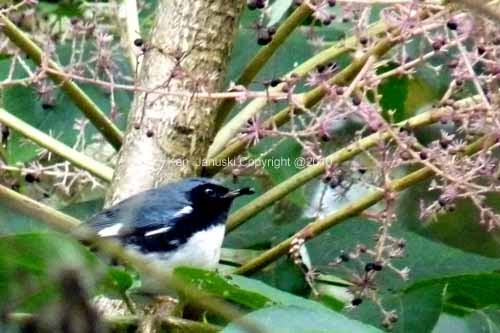I think I mentioned in my last post that this late summer/early fall is the first time that I've seen birds eating on the striking fruit of the spicebush,
Lindera Benzoin. Today I again saw birds eating it, this time American Robins. The fruit, shown above, is about the size of a large pea. Not all that large but quite a bit larger than the very, small fruit of Devil's Walkingstick.
Today's tally of birds feeding on Devil's Walkingstick included many robins, a Veery, a Northern Flicker and a Carolina Chickadee. The latter was seen on the plant. I can't say for sure that he was eating.
Not to anthropomorphize too much but it seems to me that when robins feeds on Devil's Walkingstick they are gluttonous. They just land in a crash and then start eating. When they pluck a Spicebush fruit it seems more methodical and more as though they know that they're getting a rare and irresistible delicacy. As I said this is anthropomorphizing. I'm only putting into the words the way it strikes me.
I spent three hours on Forbidden Drive along the Wissahickon today. It was a pleasure to see so many walkingstick and see birds on them. I suspect that there might have been warblers too but most of the feeding was on the furthest shrubs not the closest so it was hard to ID smaller birds.
By contrast I spent yesterday at Carpenter's Woods, normally a favorite birding spot of mine, especially in spring and fall when migrants are abundant. But not yesterday. I saw more mosquitoes than birds during the first hour. Worse most all of the Hercules Club have been destroyed. You can read about it
here. Much of the land is currently barren, a victim of cutting and herbicide done by the Philadelphia Department of Parks and Recreation. This has been threatened for over a year now.
As the link says the intent is to re-establish native trees and shrubs and thus benefit native wildlife. We shall see. It is true that many of the old oaks that are so important to Carpenters Woods have fallen. If this helps new ones grow that's all to the good. But there has never been any need to include Hercules Club in the list of invasive species. Just how invasive is a shrub that provides food to so many species?
For now though I'll not continue to go to Carpenter's Woods to see which migrants are feeding on Devil's Walkingstick. There are too few left to be of any use. Let's hope Parks and Recreation doesn't also try to apply this misguided policy to the walkingstick along the Wissahickon. There are already ominous signs there of bird habitat destroyed in the interest of some type of 'improvement.'
You have to wonder just what the migrating Black-throated Blues, among others, will feed on.
There always are those beautiful spicebush. But it won't take long for all those fruit to disappear.






